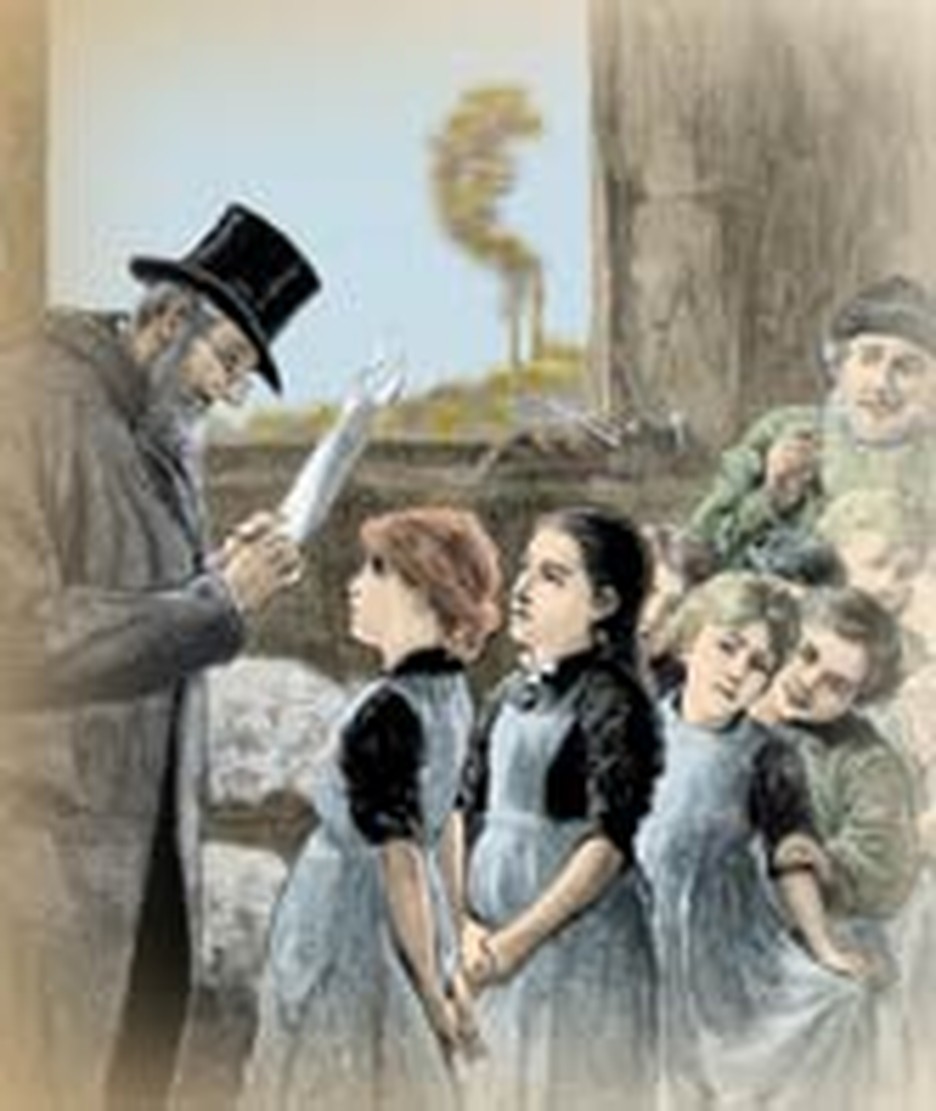
You can give without loving. But you cannot love without giving." That is what Amy used to say, and she lived it. Lived it so deeply it could get her into lots of trouble. One time it seemed sure Amy Carmichael would be arrested and thrust inside an Indian prison on kidnapping charges. And technically Amy was a kidnapper. Many times over in fact! Thirteen years earlier, in 1901, Amy sheltered her first temple runaway. Temple children were young girls dedicated to the gods and forced into prostitution to earn money for the priests. Over the years, Amy had rescued many children, often at the cost of extreme exhaustion and personal danger.
One of her recent rescues was five-year-old Kohila. Kohila's guardians wanted her back. Amy refused to return the little child to certain abuse. Instead, she made plans to cause the girl to "disappear" to a safe place. Amy was too well known to spirit Kohila away herself. So she arranged for someone else to do it. The plot was discovered. Charges were brought against her. Thus Amy faced a seven year prison term.
Amy Carmichael Was A Most Unlikely Heroine
Amy suffered neuralgia, a disease of the nerves that made her whole body weak and achy and often put her in bed for weeks on end. Friends thought she was foolish when she announced she was going to be a missionary. They predicted that she would soon be back in England for keeps. But Amy was sure God had called her to go overseas. All of her life, she had been learning to listen to his voice.
Praying for Blue Eyes
One of the first incidents occurred when she was a child. Mother had said that if Amy prayed, the Lord would answer. Amy had brown eyes. She prayed for blue. In the morning she jumped out of bed and ran to the mirror. Mrs. Carmichael heard her wail in disappointment. It took Mrs. Carmichael several minutes of careful explanation before Amy understood that "no" was an answer too. God meant Amy to have brown eyes for a reason, explained Mrs. Carmichael. Just what the reason was, she might never know. But meanwhile, brown eyes were perfectly lovely. Amy wasn't so sure. Smiling Irish blue would always be her favorite color, even if God said "No."
Amy's Youthful Escapades
There was a bit of rebel in Amy. If trouble developed at the Carmichael house, she was almost sure to be a ringleader in it. There was the time squeaks interrupted family devotions. Amy feigned ignorance, but the truth came out. The frozen mouse in her pocket had revived.
Another time she led her brothers and sisters in a challenge to see how many poisonous laburnum pods they could eat before they died. Fortunately they emerged with little more than upset stomachs. There was another time when she led them through a skylight onto the dangerous roof.
Critical Life Changes for Ms Carmichael
As a youth Amy thought she was a Christian, but an evangelist showed her she needed a personal commitment. She gave her heart to Christ. Service to him became the center and passion of her life.
After three years of boarding school, Amy returned home because her parents no longer had the money to support her education. Mrs. Carmichael took sixteen year old Amy out to buy a dress. Amy found a beautiful one -- royal blue -- but turned away from it. Her mother was surprised, but Amy explained that clothes were no longer as important to her as they once were now that Christ had given her new purpose in life. She would wait a year until her parents were better able to afford new clothes for her. She never got that dress, because the next year, Mr. Carmichael died unexpectedly.
Seeking and Saving the "Shawlies"
That was the year that Amy started classes and prayer groups for Belfast ragamuffins. She also began a Sunday work with the "shawlies." These were factory girls so poor that they could not afford hats to wear to church and wore shawls instead. Respectable people didn't want anything to do with them. Amy saw that they needed Christ just the same as their supposed "betters." Eventually so many shawlies attended Amy's classes that she had to find a building large enough to hold three hundred and more.
The Carmichaels lost all their money through financial reverses and a change became necessary. Mrs. Carmichael decided to move to England and work for Uncle Jacob. Amy and another sister joined her. Uncle Jacob asked Amy to teach his mill workers about Christ. Amy threw herself into the work, living near the mill in an apartment infested with cockroaches and bed bugs. However, she was constantly sick with neuralgia and had to lie in bed for days at a time. It was clear she must give up the work.
Amy's Call to the Mission Field
For years, Amy wanted to be a missionary. Now this desire grew so strong it hurt. She prayed about it and wrote down the reasons she thought it couldn't possibly be God's intention. One of the first things on the list was her sickness. But in her prayers she seemed to hear the Lord speak as if He were standing in her room, saying "Go."
"Surely, Lord, you don't mean it," she said. Again the voice said, "Go."
She agreed. But where should she go? And what about her widowed mother? She wrote to her mom. Mrs. Carmichael replied that the Lord had already spoken to her about it, and told her she must let Amy go. So for over a year Amy tried to find a place to go, but no one wanted her.
Nevertheless she set off for Japan in the company of three missionary ladies, a letter having been sent ahead offering her assistance to missionaries there. Tears scalded her as she sailed on March 3, 1893.
Amy had a constant passion to witness for Christ. On board the ship even the captain was converted to Christian faith after observing how cheerfully Amy faced the dirt and insects onboard.
Missionary Adjustments in Japan
Once in Japan, even before she learned the language, Amy went out to witness. Her interpreter, Misaki San, suggested Amy wear a kimono, but Amy was cold and her neuralgia was bothering her. She preferred her western dress and kept it on. The two visited a sick old woman who seemed interested in the Gospel. Just as Amy was about to ask her if she would repent, the woman caught sight of her fur-lined gloves and asked what they were.
Driving home, Amy wept bitter tears. Never again would she risk so much for so little, she promised. From then on she wore Japanese clothes while witnessing.
Praying for Lost Souls
On another occasion, Amy and Misaki San were asked to send the spirit of the fox out of a violent and murderous man. Village priests had tried their formulas and tortures without success. Trusting that the Lord could drive demons away, the two girls prayed and went boldly into the man's room. As soon as they mentioned the name of Jesus, the man went into an uncontrollable rage. If he had not been tied, he would have leaped upon them. The two girls were thrust from the room. Perplexed, they soon recovered their confidence. They assured the man's wife that they would pray until the spirit left and asked her to send a message when it was gone. Within an hour they had word. The next day, the man himself summoned them, and over the next few days they explained the way of Christ to him and he became a Christian.
Once when she was about to visit the Buddhist village of Hirose, Amy asked the Lord what she should ask of Him before she went. She felt impressed to pray for one soul. A young silk-weaver heard their message and became a Christian. Amy's neuralgia kept her in bed for a month after that. But the next time she went out, she again felt she must pray, and the Lord told her to ask for two souls. The silk-weaver brought two friends, and they gave themselves to Jesus. Two weeks later, Amy felt impressed to ask for four souls. This was more souls than many missionaries see won to Christ in a year.
The visit went badly. Amy wondered if she hadn't mistaken an arithmetical progression for the leading of the Lord. No one seemed interested in the gospel. Misaki San reminded Amy that the evening service still lay ahead. Not many came to the evening service. Those few seemed distracted. Amy was almost in tears. She wanted to run out, bury herself in the snow. Suddenly the spirit changed. A woman spoke up and asked the way to Christ, and then her son came in and committed himself to the new religion also. At the home of some Christians that evening another woman accepted Christ and the next morning a fourth.
Again Amy was ill, this time for a month and a half. For two weeks the Lord impressed Amy that she should ask for eight souls. The other missionaries chided her. "It is not faith," they said, "but presumption." With astonishment, Amy heard them advise her just to pray for a blessing. "Then you won't be disappointed." Amy insisted that the Lord himself had wrestled with her. She was terrified, she said, and would never ask this in her own strength. An older missionary agreed with her. He read God's promise from Jeremiah that nothing is too hard for the Lord. "Let us pray for her," he said.
Needless to say, eight souls took the Christian way on that visit. Amy did not receive any more impressions for numbers of souls. In fact, her neuralgia became so bad that the doctor told her she must leave Japan for a more suitable climate.
Amy Goes to India
After some struggle and confusion Amy accepted that she would be better off in India. Once there she learned about the temple girls. Even Christians were against Amy when she stepped into the struggle to end the wicked service required of the little girls. They thought she exaggerated the situation. Indeed, the truth of what went on behind the scenes was so hard to get at, that Amy found she must pretend to be an Indian and visit the temples herself. Dressed in a sari with her skin stained, she could pass as a Hindu. Now she understood why God had given her brown eyes. Blue eyes would have been a dead giveaway!
Amy's experiences were proof that the Lord truly is in charge of our lives. Even when she became permanently bedridden, God had plans for her. She wrote books that became a deep spiritual witness.
Amy Carmichael did not go to prison. A telegram arrived on February 7, 1914, saying, "Criminal case dismissed." No explanation was ever forthcoming, but those who know Amy's Lord suspect He had a hand in the decision.
Resources:
- "Carmichael, Amy." Biographical Dictionary of Evangelicals. Timothy Larsen, editor. Downers-Grove, Illinois: Intervarsity Press, 2003.
- Davis, Rebecca Henry: With Daring Faith. Greenville, South Carolina: Bob Jones University, 1987.
- Houghton. Amy Carmichael. London: Hodder and Stoughton.


